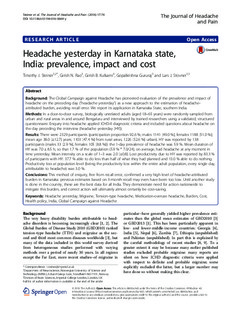| dc.contributor.author | Steiner, Timothy J. | |
| dc.contributor.author | Rao, Girish N. | |
| dc.contributor.author | Kulkarni, GB | |
| dc.contributor.author | Gururaj, Gopalakrishna | |
| dc.contributor.author | Stovner, Lars Jacob | |
| dc.date.accessioned | 2019-01-21T09:04:08Z | |
| dc.date.available | 2019-01-21T09:04:08Z | |
| dc.date.created | 2016-11-07T11:14:12Z | |
| dc.date.issued | 2016 | |
| dc.identifier.citation | The Journal of Headache and Pain. 2016, 17:74 . | nb_NO |
| dc.identifier.issn | 1129-2369 | |
| dc.identifier.uri | http://hdl.handle.net/11250/2581396 | |
| dc.description.abstract | Background
The Global Campaign against Headache has pioneered evaluation of the prevalence and impact of headache on the preceding day (“headache yesterday”) as a new approach to the estimation of headache-attributed burden, avoiding recall error. We report its application in Karnataka State, southern India.
Methods
In a door-to-door survey, biologically unrelated adults (aged 18–65 years) were randomly sampled from urban and rural areas in and around Bengaluru and interviewed by trained researchers using a validated, structured questionnaire. Enquiry into headache applied ICHD-II diagnostic criteria and included questions about headache on the day preceding the interview (headache yesterday [HY]).
Results
There were 2329 participants (participation proportion 92.6 %; males 1141 [49.0 %], females 1188 [51.0 %]; mean age 38.0 [±12.7] years; 1103 [47.4 %] from rural areas, 1226 [52.6 %] urban). HY was reported by 138 participants (males 33 [2.9 %], females 105 [8.8 %]): the 1-day prevalence of headache was 5.9 %. Mean duration of HY was 7.0 ± 8.5 h, so that 1.7 % of the population (5.9 % * 7.0/24), on average, had headache at any moment in time yesterday. Mean intensity on a scale of 1–3 was 2.0 [±0.8]. Lost productivity due to HY was reported by 83.3 % of participants with HY: 37.7 % able to do less than half of what they had planned and 13.0 % able to do nothing. Productivity loss at population level (being the productivity loss within the entire adult population, every single day, attributable to headache) was 3.0 %.
Conclusions
This method of enquiry, free from recall error, confirmed a very high level of headache-attributed burden in Karnataka: previous estimates based on 3-month recall may even have been too low. Until another study is done in the country, these are the best data for all India. They demonstrate need for action nationwide to mitigate this burden, and correct action will ultimately almost certainly be cost-saving. | nb_NO |
| dc.language.iso | eng | nb_NO |
| dc.publisher | BMC (part of Springer Nature) | nb_NO |
| dc.rights | Navngivelse 4.0 Internasjonal | * |
| dc.rights.uri | http://creativecommons.org/licenses/by/4.0/deed.no | * |
| dc.title | Headache yesterday in Karnataka state, India: prevalence, impact and cost | nb_NO |
| dc.title.alternative | Headache yesterday in Karnataka state, India: prevalence, impact and cost | nb_NO |
| dc.type | Journal article | nb_NO |
| dc.type | Peer reviewed | nb_NO |
| dc.description.version | publishedVersion | nb_NO |
| dc.source.pagenumber | 6 | nb_NO |
| dc.source.volume | 17:74 | nb_NO |
| dc.source.journal | The Journal of Headache and Pain | nb_NO |
| dc.identifier.doi | 10.1186/s10194-016-0669-y | |
| dc.identifier.cristin | 1398006 | |
| dc.description.localcode | © 2016 The Author(s). Open Access This article is distributed under the terms of the Creative Commons Attribution 4.0 International License (http://creativecommons.org/licenses/by/4.0/) | nb_NO |
| cristin.unitcode | 194,65,30,0 | |
| cristin.unitname | Institutt for nevromedisin og bevegelsesvitenskap | |
| cristin.ispublished | true | |
| cristin.fulltext | original | |
| cristin.qualitycode | 1 | |

